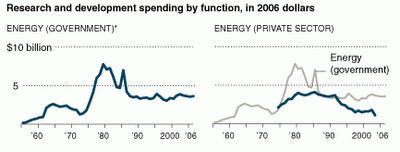Energy R&D Funding

I was surprised to learn how little the US is investing in energy research and development.
In the United States, annual federal spending for all energy research and development — not just the research aimed at climate-friendly technologies — is less than half what it was a quarter-century ago. It has sunk to $3 billion a year in the current budget from an inflation-adjusted peak of $7.7 billion in 1979, according to several different studies.That is crazy. As the environmental and geo-political reasons get stronger to reduce our usage of fossil fuels, we are investing less in R&D. While President Bush is looking to increase this to $4.2 billion in 2007, this is still an order of magnitude lower then we need.
I think we should increase energy research and development funding to $30 billion a year. I have called for a $2 gasoline tax and using part of the revenue for increased research and development. Greg Mankiw estimates a $1 gasoline tax leading to $100 billion in tax revenue. At $2, that would generate $200 billion. Take $30 billion of that to fund energy R&D and use the other $170 billion to offset other taxes, possibly the payroll tax.
Green Car Congress has been documenting some of the DOE research grants, and while I like them, they are way too small in size. $8.6 million for alternative fuels, $700,000 for poplar trees, $16 million for Electric Vehicles, $100 million for fuel cells, $64 million for biomass to hydrogen, $17.5 million for biofuels research. Only Only $416 million was spent last year on climate-friendly, renewable technologies like wind, solar power, cellulosic ethanol and hydrogen.
To put government R&D spending in comparison:
Federal spending on medical research, by contrast, has nearly quadrupled, to $28 billion annually, since 1979. Military research has increased 260 percent, and at more than $75 billion a year is 20 times the amount spent on energy research.Lets spend as much on energy R&D as we do on medical research.
“We’ve got a $12 trillion capital investment in the world energy economy and a turnover time of 30 to 40 years,” said John P. Holdren, a physicist and climate expert at Harvard University and president of the American Association for the Advancement of Science. “If you want it to look different in 30 or 40 years, you’d better start now.”
The US is not alone in underfunding.
Internationally, government energy research trends are little different from those in the United States. Japan is the only economic power that increased research spending in recent decades, with growth focused on efficiency and solar technology, according to the International Energy Agency.If the US was smart, we would ask other countries to match our increase in spending. The benefits of this R&D will help everyone in the world, so why shouldn't every country pitch in? The Europeans and Japanese get the benefits of US R&D in pharmaceuticals without paying their fair share. If American tax payers are going to be asked to fund the development of next generation energy sources, so should the Europeans and Japanese.
What should the increase in funding for R&D go towards? Increased efficiency of solar panels, new battery technology for cars, a way to store large amounts of energy from solar and wind power, improvements in bio-fuels, new nuclear technology, carbon sequestering, and other new radical ideas. Who knows where the winners will be, so invest in a portfolio of different ideas. Invest in the basic science and ideas that are 10 years or more from being practical.
Some might ask why the private market can't handle this.
While private investors and entrepreneurs are jumping into alternative energy projects, they cannot be counted on to solve such problems, economists say, because even the most aggressive venture capitalists want a big payback within five years.It is all about time frame. Let private industry fund the ideas that are only a few years away from prime time, but have government fund the long range ideas. This was a successful strategy with respect to the Internet and microprocessors and it will be for energy as well.
via NY Times





No comments:
Post a Comment
Note: Only a member of this blog may post a comment.